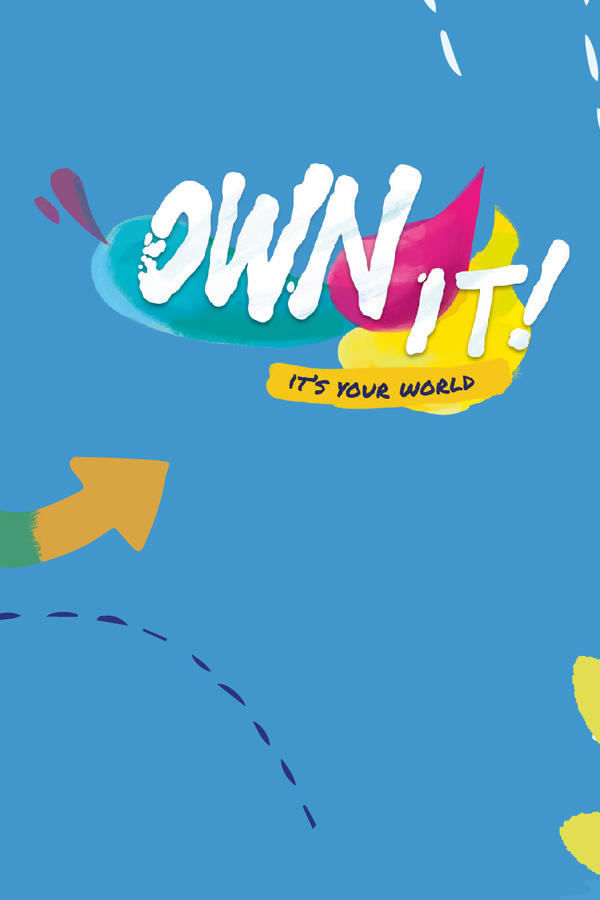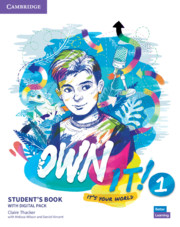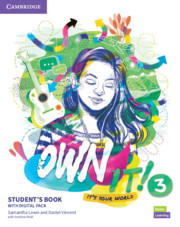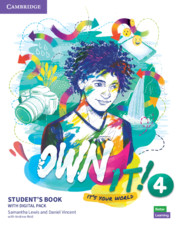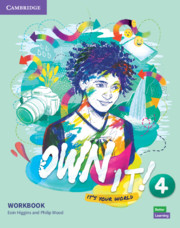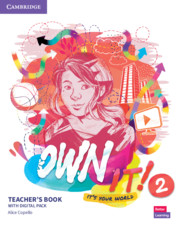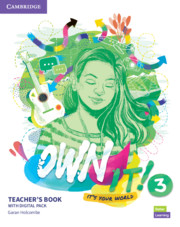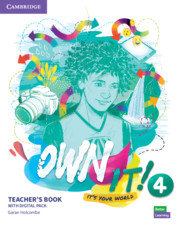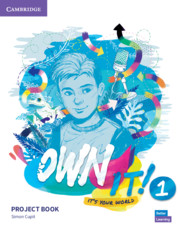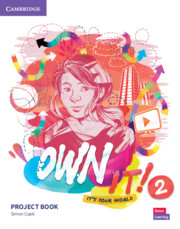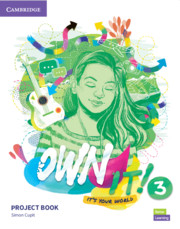Own It!
Key features
Practise the skills to work effectively with others on collaborative projects.
Get inspired through global, cross-curricular topics and up to 45 videos per level.
Practise your skills with mobile-friendly Practice Extra and a cutting-edge digital collaboration space.
Test & Train provides perfect on-the-go, intuitive exam preparation and offers a digital practice test experience in Cambridge One
Become a more independent learner and navigate life's challenges using the Cambridge Life Competencies Framework.
Build the confidence to succeed in A2 Key for Schools, B1 Preliminary for Schools and other international exams.
What makes Own It! special?
Own it! digital package on Cambridge One includes:
- Presentation Plus - class presentation tool - accessible online and offline.
- Practice Extra - Mobile friendly, bite-sized extra practice activities and games for every unit.
- Collaboration Plus - a tool which enables students to collaborate on projects remotely.
- Teacher's Resource Bank - downloadable worksheets and tests at different levels of challenge.
Explore our Own it! digital materials
Global cultural topics are brought to life with documentary videos and inspiring texts, exposing students to people and places from around the world. Students can explore street art in Sao Paolo, volunteer in Costa Rica and join eagle hunters in Mongolia, all from the comfort of their classroom.

A project page for every unit develops students' collaborative skills while consolidating language learning in a fun, personalised way. The new Collaboration Plus tool enables students to collaborate on projects remotely.
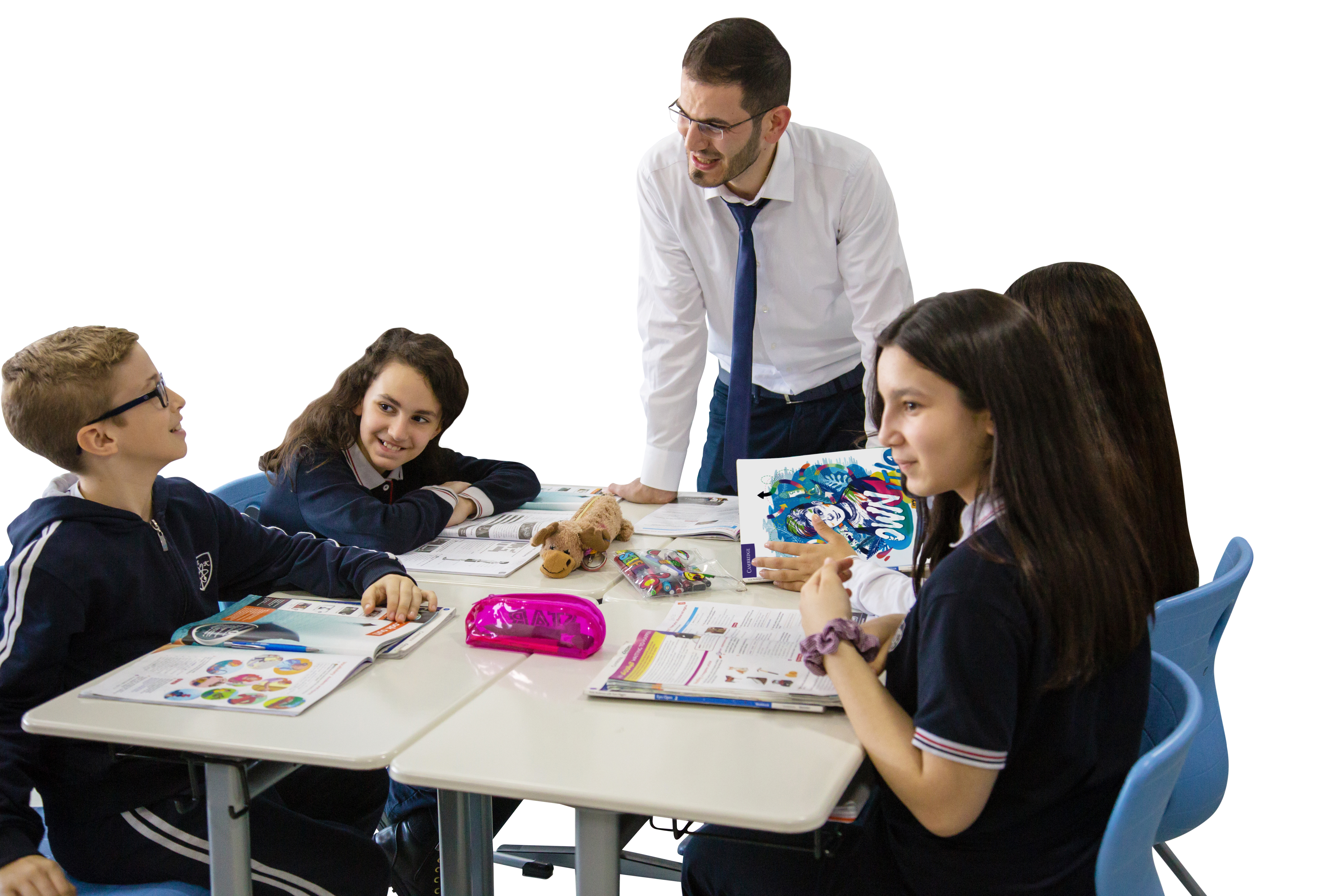
Own it! includes four or five high-quality videos per unit designed to activate prior knowledge and provide support for learning
- Documentaries appear at the beginning of every unit, a great way to get students thinking about the unit topic.
- Language in Action videos appear on the grammar pages of the unit, featuring teenagers using the target
- Everyday English videos appear on the speaking pages with teenagers using authentic English from the speaking dialogue.
The Learn to Learn feature of the course is designed to introduce students to vital learning strategies and techniques, helping them become more independent, lifelong learners.

The project work in every unit allows students to …
- build collaborative skills, such as communication, teamwork and leadership.
- acquire practical, transferrable skills associated with different types of projects, like doing research and making presentations.
- explore areas that they are interested in, thereby increasing their motivation.
- continue to collaborate remotely, using the new Collaboration Plus tool on Cambridge One.
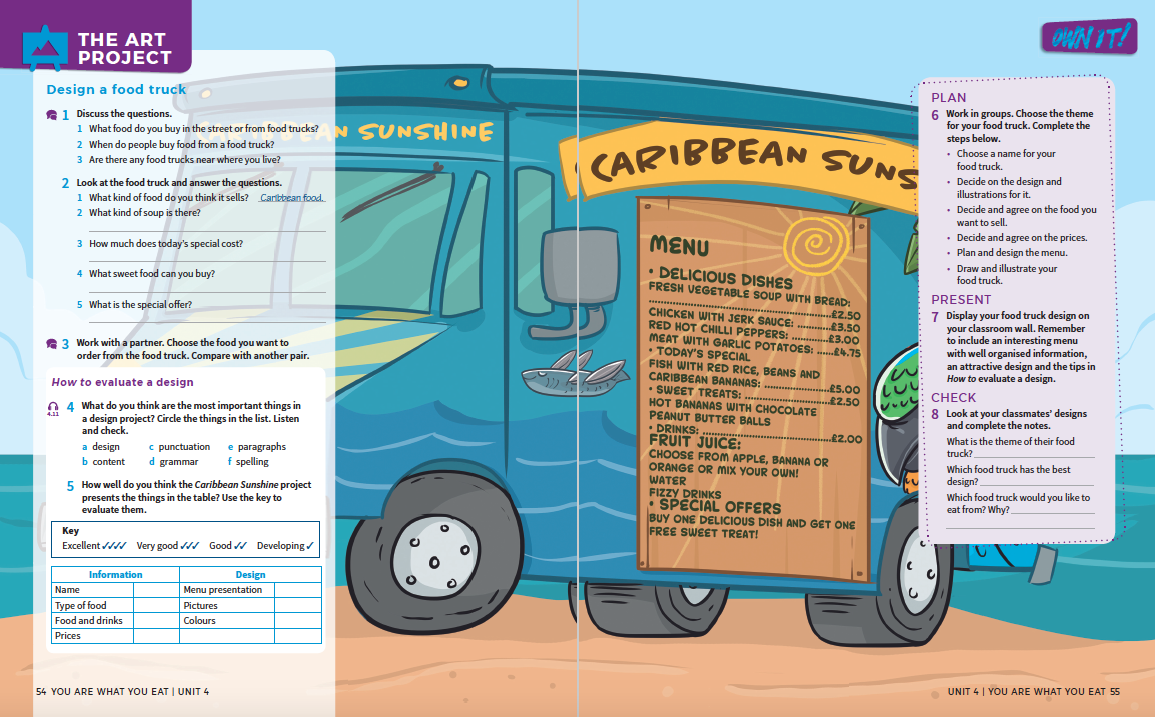
In Own it! there is extensive support for teachers with mixed-ability classes, including the following:
- Finished? icons direct fast finishers to fun extra practice at the back of the book to ensure all students are challenged.
- Workbook activities are graded 1, 2 or 3 stars to indicate their difficulty level
- Teacher’s Book notes provide suggestions for grading activities to different students’ abilities.
- Project Book teacher’s notes provide specific suggestions for differentiated instruction.
How to find out more
Request free sample
Get an e-sample that will allow you to view a product preview on your desktop.
Free sampleSample content
Join the conversation

Learn to Learn
The Learn to Learn feature of Own it! is designed to introduce students to vital learning strategies and techniques which will help them become more independent learners, all aligned to the Cambridge Life Competencies Framework.
These competencies are developed in the Learn to Learn feature which appears throughout the unit and in the Learn to Learn page at the end of each unit.
This page from Level 1 Unit 1 helps students organise their notebook by encouraging them to look at an example of a notebook, compare it with their own, and finally, reflect on how theirs could be improved.
Background
When students reach Secondary school, they are expected to start taking more and more responsibility for their own learning, and once they reach school leaving age, they should have acquired the ability to learn independently. The rapid rate of technological advancement means that many jobs in the near future may become automated. To give the next generation the best chance in life, they need to be able to acquire new skills and knowledge throughout their lives, making them adaptable to whatever the future holds.
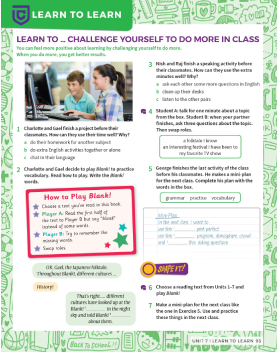
Yet teachers often find that their students do not know how to learn, and lack basic learning techniques like taking notes, categorising information, and assessing their strengths and weaknesses, particularly in the first year of Secondary school.
The Learn to Learn sections cover three broad areas of learner training:
- practical skills for participating in learning
- taking control of their own learning
- reflecting on and evaluating own learning success.
After each Learn to Learn tip, students practise them immediately in an activity. This helps students incorporate these techniques into their learning routine.
Project work
Collaboration is a key strand of this course. Own it! includes a CLIL project in every even-numbered unit of the Student’s Book and a Culture Project for every odd-numbered unit available in the Teacher’s Resource Bank on Cambridge One. These are accompanied by a Project Book with step-by step guides and practical tips for teachers.

This project from Level 1 Unit 6 asks students to analyse some of the key features of a model project before planning and creating their own. Finally, they can evaluate other groups’ tasks.
Rationale
Collaboration is an effective way of empowering students, allowing them to take ownership of their learning. Own it! includes a project in every other unit of the Student’s Book with more available in the Teacher’s Resource Bank in Cambridge One, as well as an accompanying Project Book which offers full support and practical tips for teachers.
Project work allows students to:
- build collaborative skills, such as communication, teamwork and leadership.
- acquire practical, transferable skills associated with different types of projects, like doing research and making presentations.
- choose and explore areas that they are interested in, thereby increasing their motivation.
- engage with the real-world issues as projects are often interdisciplinary and based on real world scenarios.
However, preparing project work can be very time-consuming for teachers. That’s why Own it!’s projects are aligned to the topic of the unit, with a step-by step guide and practical tips for students, plus a full teacher’s guide in the Project Book. This is project work made simple!
In response to teacher feedback, the projects in the Student’s Book have a cross-curricular approach, covering topic areas like Science, Art, Music, and Maths, giving students the opportunity to improve their subject knowledge whilst exploring a wide variety of topics in English. The Around the World pages also have an optional double page project available on Cambridge One, which allows students to further explore the cultural theme of the unit.
All of the projects develop competencies from the Cambridge Life Competencies Framework. The areas covered in each project are clearly mapped at the beginning of the Project Book.
Global topics
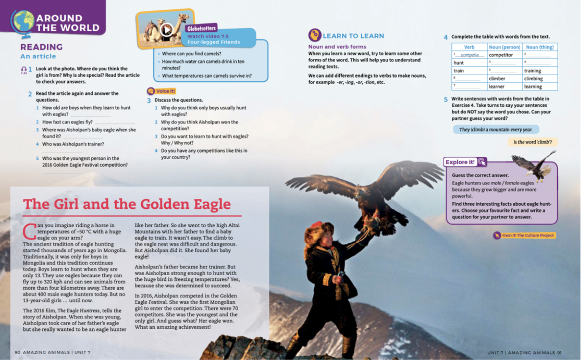
Own it! has a global, cultural focus, with topics from traditional dress to unique festivals. The documentaries and the Around the World pages bring these global topics to life, exposing students to people and places from around the world, and asking questions which encourage students to think about the differences between their culture and other cultures.
Rationale
Own it! includes a variety of global topics, with a dedicated Around the World page in every other unit. This helps students broaden their understanding of other people and places, preparing them for life in a diverse, multi-cultural environment.
Learners of English now outnumber speakers of English as a first language. Students are therefore far more likely to use English to communicate with people whose first language is not English. This has significant implications for traditional English teaching because an understanding of the language is now only part of successful communication and we cannot underestimate the role of cross-cultural understanding in communication.
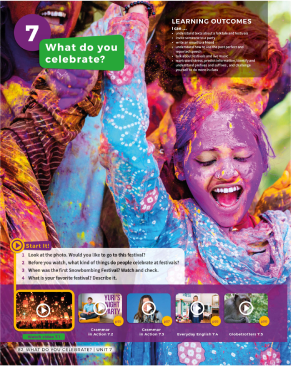
Schema theory suggests that as humans learn, we create mental shortcuts by organising information into categories. These categories, or schemata, enable our brains to deal with most 'typical' scenarios without too much effort, since we can base our responses on our expectation. Students who are told they are going to hear a conversation at a train station can reasonably expect to hear certain language: train times, platform numbers and ticket types. Their expectations about these scenarios help them listen more effectively.
Teachers will be aware that their students are already interacting with globalised media. From watching international TV shows to playing online video games, teenagers are already encountering English being used by both native and non-native speakers from different cultural and social backgrounds. This interconnectedness is only going to increase, so it is vital that students develop the skills they need to communicate effectively.
That’s why Own it! has a global, cultural focus, alongside documentaries in every unit, all of which encourage students to think about the differences between their culture and other cultures.
Mixed-ability support
In Own it!, there is extensive support for teachers with mixed-ability classes, including graded Workbook activities, suggestions for differentiating activities, an entire Project Book guiding teachers through each project and graded grammar and vocabulary worksheets.

When students arrive at Secondary school, they may have spent more or less time studying English than their classmates. The average English class will have students with a variety of different language abilities, not to mention different interests, levels of motivation and learning preferences. In Own it! there is extensive support for teachers with mixed-ability classes, including the following:
Teacher’s Book notes provide suggestions for grading activities to different students’ abilities.
Project Book teacher’s notes provide specific suggestions for differentiated instruction. These cater for students who need more support as well as students who would benefit from more challenge.
Graded grammar and vocabulary worksheets at three different levels can be found in the online Teacher’s Resource Bank.
On the Student’s Book page, Finished? icons direct fast finishers to fun extra practice at the back of the book to ensure all students are challenged.
Workbook activities are graded 1, 2 or 3 stars to indicate their difficulty level. This means that students can start at the easiest level and move onto more difficult activities when ready. Alternatively, teachers can set different activities for different students according to their ability.

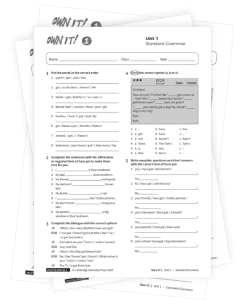
Teen-friendly video
Own it! includes four to five videos per unit made especially for the course. As well as documentaries, there are grammar vlogs and Everyday English videos designed to appeal to the teenage learner.
Documentaries
Documentaries appear at the beginning of every unit. Along with the striking opening image, and Start it! questions, they are a great way to get students thinking about the unit topic and activate any prior knowledge and language they may have.
Documentaries also appear on the Around the World pages in every other unit. These contextualise the grammar and vocabulary of the unit and are linked to the topic of the reading. Teachers have the choice of asking students the questions on the page or using the full video lesson in the downloadable video worksheets in the Teacher’s Resource Bank.
Language in Action videos
Language in Action videos appear on the grammar pages of the unit. These fun vlogs feature teenagers using the target language in context. Each vlog is followed by an animated presentation of the grammar, using real examples from the video. They are designed to make teaching and learning grammar more meaningful, and give the teacher the option of using a flipped classroom model by getting students to watch the video before class.
Everyday English videos
Everyday English videos appear on the speaking pages. Teachers often find that students love learning the latest colloquial words and real phrases in English, and these videos are a great way of presenting this. They feature teenagers using authentic English from the speaking dialogue, and give students the chance to try out these phrases for themselves.
Digital tools
To access the Own it! digital materials, go to cambridgeone.org.
The Own it! digital package has everything you need in one place on Cambridge One:
Plan: All your teaching materials, all in one place.
Present: Interactive Student's Book and Workbook with embedded audio and video, perfect for heads-up learning.
Practice: Mobile-friendly bite-sized practice activities and games for every unit of the Student's Book.
Collaborate: Students can collaborate on project work remotely.
Motivate: Medals for completing activities provide motivation to do extra practice.
Assess: See student performance at a glance and download ready-made tests.
Presentation Plus
- Student’s Book and Workbook with interactive exercises.
- Click-to-play audio and video
- Extra class activities, only available on Presentation Plus
- Games
- Accessible online and offline
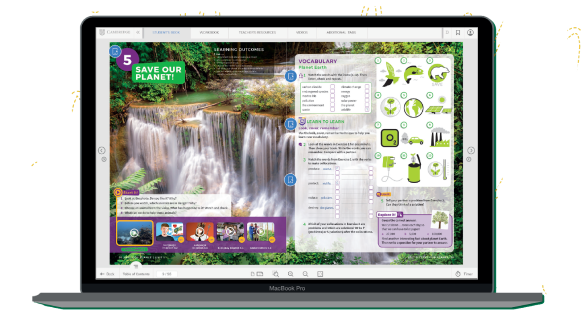
Practice Extra
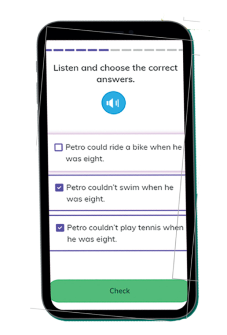
- Mobile friendly platform and content.
- Bite-sized learning activities.
- Online speaking tasks with audio and video.
- Performance tracking and gamification.
Collaboration Plus
Students can collaborate remotely in the collaboration space, where teachers can set, track and assess students’ work.
Teachers Resource Bank
Online teacher resource area with culture projects, graded grammar and vocabulary practice worksheets, video worksheets, communication worksheets, writing template worksheets, video grammar vlogs, speaking extra activities, and more!
Test Centre, including end-of unit, term and year tests, and exam practice tests.
Own it! and the Cambridge Life Competencies Framework
How can we prepare our students to succeed in a world that is rapidly changing? We need to help students develop transferable skills, to work with people from around the world, to think creatively, to analyse sources critically and communicate their views effectively. How can we teach these alongside language?
In response to these questions, Cambridge University Press has developed the Cambridge Life Competencies Framework. This Framework underpins the syllabus for the Learn to Learn pages and the collaborative project work in Own it!, helping teachers recognise and assess the many transferrable skills that the course develops.
The Framework is split into 3 levels of detail. First, there are 6 Competencies. Each area is then split into the Core Areas your students need to develop within the competencies. Finally, within each core area, there are a number of Can Do Statements, which outline how a student, depending on their age, would demonstrate this Core Area.
Let’s take the Learning to Learn area as an example:
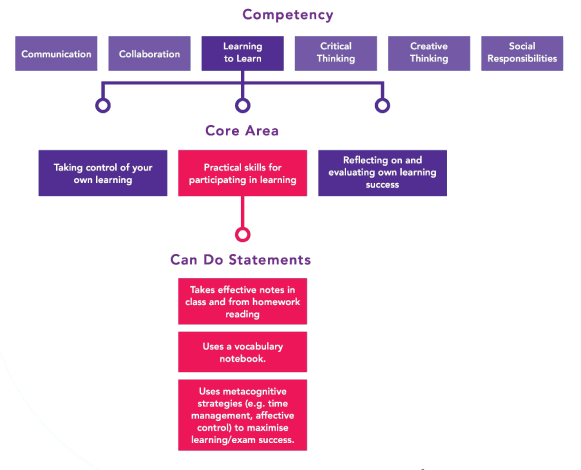
Learning to Learn
These competencies are developed in the Learn to Learn feature which appears throughout the unit and in the Learn to Learn page at the end of each unit.
This page from Level 1 Unit 1 helps students organise their notebook by encouraging them to look at an example of a notebook, compare it with their own, and finally, reflect on how theirs could be improved.
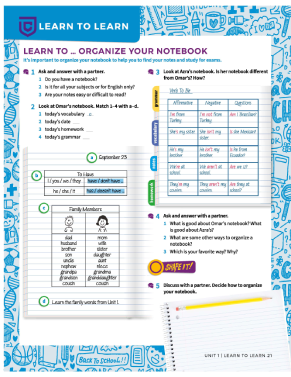
Collaboration
The collaboration area of the Cambridge Life Competencies Framework also plays a huge part in the course, through projects in Student’s Book and in the Teacher’s Resource Bank on Cambridge One. All of which have extensive support and guidance in the Project Book.
This project from Level 1 Unit 6 asks students to analyse some of the key features of a model project before planning and creating their own. Finally, they can evaluate other groups’ tasks.
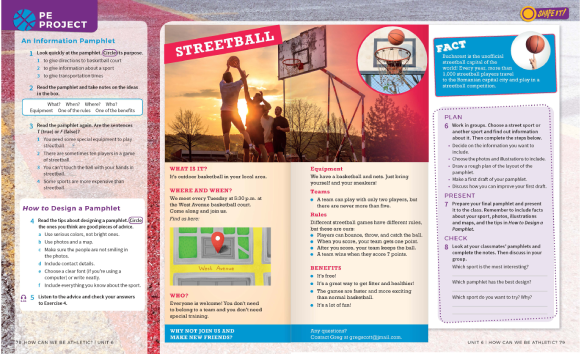
Notes from the Authors of Own it!
Daniel Vincent
Daniel Vincent has taught English for over 15 years in the UK, Japan and Spain, and has experience in materials and course development.
With group, pair and project work being a key component in the teenage classroom, collaboration is a key skill needed to complete this work successfully. In Dan’s webinar, he covers the benefits of collaborative learning and project work, specifically looking at why we should get our students to undertake this type of work and why we should develop their collaborative skills.
Interested in reading more content from Dan Vincent?
Dan has also contributed to the Cambridge University Press blog, with his 'Teens together' series, including lots of practical tips on how to incorporate project work into your classroom:
Teens together #1: Collaborative project work – the benefits of building towers
Teens together #2: Collaborative project work – each pair’s in charge of at least one sound effect
Teens together #3: Collaborative project work – Undergoing problems? Here’s how to overcome them…
Teens together #4: Collaborative project work – museums
Teens together #5: Collaborative project work – music
Samantha Lewis
Samantha Lewis has worked in ELT since 1994 as a teacher, teacher trainer, CELTA trainer and materials writer in Spain and the UK. Before Own it!, she co-authored Interactive and Tactics, a Cambridge University Press coursebook for Spanish upper secondary students.
Interested in reading more content from Samantha?
Find more articles on the Cambridge University blog, World of Better Learning:

